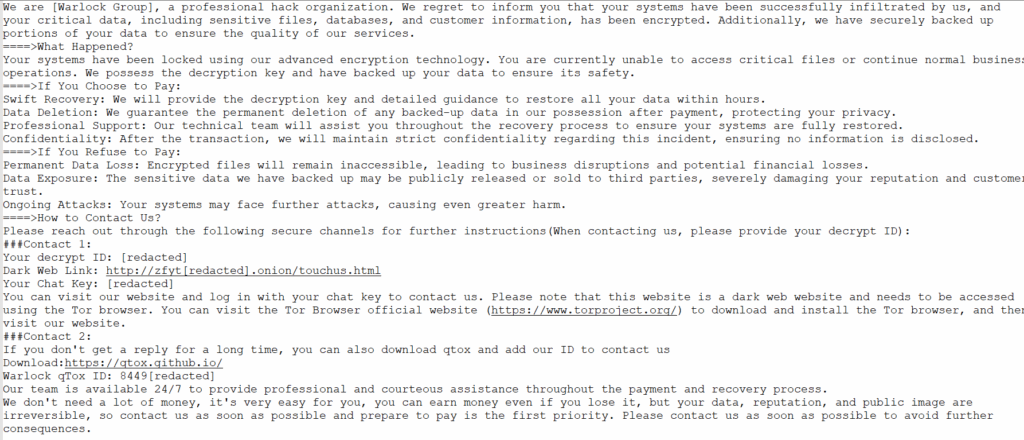

Key Findings
- Check Point Research (CPR) conducted a focused analysis of Storm-2603, a threat actor associated with recent ToolShell exploitations, together with other Chinese APT groups.
- Storm-2603 utilizes a custom malware Command and Control (C2) framework dubbed internally by the attacker as “ak47c2”. This framework includes at least two different types of clients: HTTP-based (dubbed by us “ak47http”) and DNS-based (dubbed by us “ak47dns”).
- Based on VirusTotal data, Storm-2603 likely targeted some organizations in Latin America throughout the first half of 2025, in parallel to attacking organizations in APAC.
- Some of the actor’s TTPs align with many other ransomware groups, and involve open-source tools such as PsExec and masscan. In addition, the threat actors use a custom tool that leverages the BYOVD (Bring Your Own Vulnerable Driver) technique to tamper with endpoint protections.
- Storm-2603 attacks involved multiple ransomware families, sometimes bundled together. Those are commonly deployed by abusing DLL hijacking.
Introduction
Check Point Research (CPR) has been closely monitoring the ongoing exploitation of a group of Microsoft SharePoint Server vulnerabilities collectively referred to as “ToolShell.” These active attacks leverage four vulnerabilities—CVE-2025-49704, CVE-2025-49706, CVE-2025-53770, and CVE-2025-53771—and are attributed to multiple China affiliated threat actors.
Among the threat groups identified by Microsoft, two are known APTs: Linen Typhoon (aka APT27) and Violet Typhoon (aka APT31). Another group is a newly observed, previously undocumented cluster called Storm-2603. While Microsoft linked this cluster’s activity to potential ransomware deployment, it was unable to assess the group’s objectives.
As part of our ongoing investigation into ToolShell and its associated risks, we launched a targeted effort to better understand and characterize the threat posed by Storm-2603. Throughout our analysis, we uncovered several files likely tied to Storm-2603 intrusions, offering new insights that correspond to Microsoft’s description of the group.
In this publication, we provide an in-depth examination of Storm-2603’s tactics, techniques, and procedures (TTPs), along with a technical breakdown of the ak47c2, a custom malware framework used in their attacks and their different ransomware payloads.
Background
Storm-2603 was first mentioned by Microsoft during investigations into a set of attacks on Microsoft SharePoint servers, known as the “ToolShell” campaign. While some activity was tied to known Chinese affiliated groups like Linen Typhoon (APT27) and Violet Typhoon (APT31), Storm-2603 appeared as a new, previously unreported actor. Microsoft linked the group to Lockbit and Warlock ransomware use.

Figure 1 – Events associated with Storm-2603.
Microsoft’s report provided only limited information about Storm-2603, including some of the TTPs associated with it, most of them quite generic. In addition, some of the reported indicators of compromise (IOCs) helped us uncover additional artifacts associated with previous Storm-2603 intrusions.
One domain in particular, update.updatemicfosoft[.]com, linked to Storm-2603’s SharePoint exploitation, turned out to have been used in earlier campaigns dating back to March 2025. In those operations, it served as a C2 server for both DNS tunneling malware and an HTTP backdoor and was part of infrastructure used to deliver LockBit Black and Warlock/x2anylock ransomware.
Incidents
Our search for cases where the IOCs reported by Microsoft, revealed two incidents in which LockBit Black and WarLock ransomware variants were deployed together, in addition to multiple other tools, mostly open-source.
Case #1 – Open-source tools, custom backdoor, ransomware
In April 2025, a RAR archive named Evidencia.rar was uploaded to VirusTotal. The archive contains several artifacts likely extracted from compromised machines in a Storm-2603 case in a LATAM country. The artifacts in the archive provide a look at some of the open-source tools used by the actors in the intrusions which correlates with previous knowledge of the group:
- masscan – Scans large IP ranges for open ports.
- WinPcap – Captures and filters network traffic on Windows.
- PsExec – Executes commands on remote Windows systems.
- SharpHostInfo – Collects host and domain info on Windows environments.
- nxc – Exploits common vulnerabilities in network services.
In addition to the open-source tools, the archive also contains the custom backdoor used by the group, as well as its unique ransomware payloads.
- dnsclient.exe – A custom backdoor utilized by Storm-2603 that communicates over DNS tunneling with update.updatemicfosoft[.]com, a domain associated with the group. See the next section for our analysis of the backdoor.
- 7z.exe & 7z.dll – Legitimate 7z executable side-loading malicious 7z.dll delivering X2anylock (aka Warlock), a ransomware used by Storm-2603.
- bbb.msi – An installer which uses clink_x86.exe to side-load clink_dll_x86.dll, leading to the execution of LockBit Black ransomware.
Case #2 – Custom AV killer, ransomware
Another MSI file uploaded to VirusTotal in April used a similar deployment method, starting with the MSI installer to launch multiple ransomware strains simultaneously:

Figure 2 – MSI Multi-Ransomware Deployment.
The MSI relies on the following files:
- MpCmdRun.exe & Mpclient.dll – Warlock Ransomware, deployed via DLL-hijacking.
- clink_x86.exe & clink_dll_x86.dll – LockBit Black ransomware, deployed via DLL-hijacking.
- z.exe & z.dll – x2anylock ransomware, deployed via DLL-hijacking.
- VMToolsEng.exe – Custom Antivirus Terminator.
- ServiceMouse.sys – Vulnerable driver used by VMToolsEng.exe for killing Antivirus processes.
- log.exe – A list of Antivirus processes to kill.
- msi.bat – Executes VMToolsEng.exe.
- 1.bat – Executes all the needed executables and the MSI.
AK47 C2 Framework
We attributed two custom backdoors to Storm-2306, both of which appear to be part of the framework named AK47 C2 based on the shared PDB path: C:\Users\Administrator\Desktop\work\tools\ak47c2\.
AK47DNS backdoor
The sample appears to be a 64‑bit console backdoor called dnsclinet (typo in the source) whose debugging symbols point to:
C:\Users\Administrator\Desktop\work\tools\ak47c2\dnsclinet-c\dnsclient\x64\Release\dnsclient.pdb
When executed, the program immediately hides its console window, determines the host computer name (defaulting to unknown.local if that fails), and builds a DNS‑based command‑and‑control payload. It chooses a random five-character session ID, such as H4T14, and prefixes it with 1 for task requests or 2 for result uploads (e.g., 1H4T14 or 2H4T14). Each element, such as the task/result tag, a size flag (a for “all” when the entire message fits into one request), and the computer name, is XOR‑encoded with the ASCII key “VHBD@H”, converted to hexadecimal, and concatenated with dots before being prepended to the C2 domain update.micfosoft[.]com. This what the overall query looks like:
<task|result><sessionID>.a<sessionID>.<computerName>.update.micfosoft[.]com
DNS TXT and MG (a mail group member record type) record lookups (DnsQuery_A) are used to transmit and retrieve data. If the C2 server is unreachable, the client simply receives error 9003 (DNS_ERROR_RCODE_NAME_ERROR). Otherwise, the response text is decoded from hex, XOR‑decrypted, and parsed for the delimiter “:::”, which separates metadata from the actual command string. Commands run under cmd.exe /c <command> 2>&1; a built‑in directive sleep n pauses execution for n seconds.
For outputs larger than 0xFF bytes, the backdoor fragments data into 63‑byte sub‑segments. Each DNS query then follows:
<task|result><sessionID>.**s**<sessionID>**t**<TOTAL>**p**<POS>.<segment1>.<segment2>.update.micfosoft[.]com
Where:
- s marks segmentation
- t gives the total segment count, and
- p indicates the position of the current pair of segments
AK47HTTP backdoor
HttpClient backdoor has the pdb path C:\Users\Administrator\Desktop\work\tools\ak47c2\httpclient-cpp\x64\Release\httpclient-cpp.pdb and uses plain HTTP instead of DNS for the C2.
It is built as a 64‑bit console program that also immediately hides its window on launch.
On start‑up, the malware gathers the host computer name (similar to the DNS version, it defaults to unknown.local), then builds a JSON object with the fields cmd, cmd_id, fqdn, result, and type.
For a task request, the object looks like this: {"cmd":"","cmd_id":"","fqdn":"<computer>","result":"","type":"task"}
After the host executes a command, the result is sent back with type:”result”.
Before transmission, the entire JSON blob is XOR‑encrypted with the ASCII key “VHBD@H”, converted to hexadecimal, and placed in the body of an HTTP POST to “/” with generic headers (Content‑Type: text/plain, Accept: */*). The C2 replies with a similarly encoded JSON where the cmd field contains the next command. The implant executes it via cmd.exe /c <command> 2>&1 and returns the output.
Ransomware
We identified that during these attacks, several types of ransomware were deployed simultaneously. One is regular LockBit Black, and the second uses the.x2anylock extension. This extension was later used by the Warlock ransomware operator, mentioned in Microsoft’s report on the SharePoint exploitation.
The Warlock ransom note is usually saved as How to decrypt my data.txt and looks like this:

Figure 3 – Warlock Group ransom note.
The ransom notes for all ransomware strains deployed by Storm-2603 are named How to decrypt my data.log (x2anylock) or <Ransomware ID>.README.txt (LockBit Black) and have the same short content:
Your decrypt ID: [redacted] Tox ID Support: 3DCE[redacted] Email Support: [redacted]@proton.me,[redacted]@proton.me,[redacted]@proton.me You can contact us in email or qtox.
This ransom note’s name How to decrypt my data.log appeared in a recent LinkedIn post by Huntress, describing the case where multiple ransomware families were deployed together against the same target. While not a new tactic, this approach is rarely observed among established ransomware groups.
Antivirus Terminator
An important part of the infection package described earlier is called Antivirus Terminator. It is a custom command line tool abusing a third-party signed legitimate driver to kill processes. From what we can see, it’s been in the wild since at least late 2024.
The tool requires administrative privileges on the infected machine. The screenshot below shows how the listing is displayed in the console when the tool is run without parameters:

Figure 4 – Antivirus Terminator supported arguments when run without parameters.
The tool first creates a service called ServiceMouse, where the path to the service binary file is ServiceMouse.sys from the package.

Figure 5 – Antivirus Terminator installs third-party service.
Next, the tool communicates with the installed service via IO control code 0x99000050, which is responsible for killing processes. The tool also has more capabilities, like deleting files and uninstalling drivers, and these use different IO control codes (0x990000D0 and 0x990001D0).

Figure 6 – Antivirus Terminator kills process using third-party driver.
The supplied third-party driver is a legitimate and signed component of Antiy System In-Depth Analysis Toolkit, originally named AToolsKrnl64.sys. The toolkit was developed by Antiy Labs, a Chinese security vendor, and features a graphical user interface that allows users, among others, to interact with and manipulate processes. The ability to kill processes is the most important feature which is abused by threat actors in this particular case.

Figure 7 – Antiy System In-Depth Analysis Tookit GUI.
The following piece of code in the driver handles the IO control code 0x99000050 mentioned above:

Figure 8 – IO control code processing in the Antiy driver.
The second function is the piece of code responsible for killing a process with a given PID.

Figure 9 – Killing processes in the Antiy driver.
Summary
In this report we analyze Storm-2603, a relatively new threat actor first mentioned by Microsoft during investigations into the “ToolShell” campaign targeting SharePoint servers. While some of the exploitation activity was tied to known Chinese APT groups, Storm-2603 stood out as a previously undocumented group linked to ransomware deployment. By examining infrastructure indicators shared in public reporting, we were able to connect this actor to earlier campaigns involving LockBit Black and Warlock/X2anylock ransomware, dating back to at least March 2025.
These earlier attacks used similar infrastructure and tools, including DNS tunneling and HTTP-based backdoors. Interestingly, multiple ransomware variants were deployed in the same attack. This behavior, along with the overlap in techniques, helps us better understand how Storm-2603 operates
IOCs
updatemicfosoft[.]com
microsfot[.]org
f711b14efb7792033b7ac954ebcfaec8141eb0abafef9c17e769ff96e8fecdf3
035998b724044d20d583fffa393907c7fef11ad8b93b4d423ad8cb8e53f248b7
abb0fa128d3a75e69b59fe0391c1158eb84a799ddb0abc55d2d6be3511ef0ea1
3b013d5aec75bf8aab2423d0f56605c3860a8fbd4f343089a9a8813b15ecc550
dbf5ee8d232ebce4cd25c0574d3a1ab3aa7c9caf9709047a6790e94d810377de
1eb914c09c873f0a7bcf81475ab0f6bdfaccc6b63bf7e5f2dbf19295106af192
d6da885c90a5d1fb88d0a3f0b5d9817a82d5772d5510a0773c80ca581ce2486d
0f4b0d65468fe3e5c8fb4bb07ed75d4762e722a60136e377bdad7ef06d9d7c22
f01675f9ca00da067bdb1812bf829f09ccf5658b87d3326d6fddd773df352574
1eb914c09c873f0a7bcf81475ab0f6bdfaccc6b63bf7e5f2dbf19295106af192
8f58da414ec4cdad2f6ac86c19e0a806886c63cfdf1fbbb5a0713dce8a0164c5
24480dbe306597da1ba393b6e30d542673066f98826cc07ac4b9033137f37dbf
aa25646ea17ae33285203c225386304de1fe4155be44bb86deb154b87b47e3fb
b5a78616f709859a0d9f830d28ff2f9dbbb2387df1753739407917e96dadf6b0
c27b725ff66fdfb11dd6487a3815d1d1eba89d61b0e919e4d06ed3ac6a74fe94
eaec6b1b23c4450d1d0a7d409d3f21e8a4a171a9e9b82bb8ef2c05a2f7435e9c
257fed1516ae5fe1b63eae55389e8464f47172154297496e6f4ef13c19a26505
ceec1a2df81905f68c7ebe986e378fec0805aebdc13de09a4033be48ba66da8b
55a246576af6f6212c26ef78be5dd8f83e78dd45aea97bb505d8cee1aeef6f17
aca888bbb300f75d69dd56bc22f87d0ed4e0f6b8ed5421ef26fc3523980b64ad
f06fe1c3e882092a23002bed3e170da7b64e6b4475acdedea1433a874b10afdf
7c31d43b30bda3a891f0332ee5b1cf610cdc9ecf772cea9b073ac905d886990d





